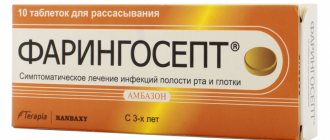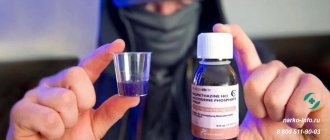Pharmacodynamics and pharmacokinetics
Loperamide is a synthetic derivative of piperidine . It acts on peripheral opioid receptors , reducing the production of acetylcholine and prostaglandins . Thus, the propulsive peristalsis of the small intestine decreases, bowel movements occur with less frequency, and the feces acquire a harder consistency.
Indications for use of the drug are frequent bouts of diarrhea. This is due to the ability of the drug to increase the tone of the anal sphincter and reduce the frequency of bowel movements.
After taking the tablets, they quickly enter the bloodstream after being absorbed into the gastrointestinal tract . 4-5 hours after administration, loperamide reaches its maximum concentration in the blood plasma and, in a fairly small amount, can penetrate the blood-brain barrier .
It undergoes metabolic reactions in the liver, is excreted after 9-14 hours in the feces, and a small amount is excreted through the kidneys.
Due to the fact that the drug is metabolized in the liver, consultation with a doctor and dose adjustment for patients with liver disease is required.
special instructions
In this category, every patient will find some useful information for themselves.
Driving
During treatment you should refrain from driving.
Pregnancy
During pregnancy, you should stop taking Lipedium.
In childhood
No information was provided on the possibility of taking the medicine in childhood.
With impaired kidney function
In rare cases, dosage adjustment may be required.
With impaired liver function
The medication cannot be taken if the liver function is impaired.
Sales of goods
Without a doctor's prescription.
Indications for use
The drug can be prescribed for any type of diarrhea .
Lopedium - what are these pills for?
- treatment of chronic, allergic, emotional, medicinal and radiation diarrhea;
- an additional remedy for the treatment of infectious diseases of the gastrointestinal tract (together with antibiotics );
- diarrhea caused by a change in diet, metabolic disorders, and certain gastrointestinal tract ;
- elimination of diarrhea during ileostomy .
Lopedium tablets - for what else?
An indication for the use of the drug may also be digestive disorders in tourists ( traveler's diarrhea ). Capsules can be taken for 2 days. If blood appears in the stool, you should consult a doctor.
How to take in case of acute condition
Typically, in acute conditions with the disorder, two capsules of Lopedium are taken at once, and then one after each bowel movement. But there is an important detail: if the diarrhea contains bloody spots and you have a fever, then you should not take Lopedium.
If the patient is a small child or teenager 6-17 years old, then only one capsule is taken and one capsule is taken with each subsequent visit to the toilet. The limit for adults is 8 capsules in 24 hours. For children weighing 20 kg, the maximum is up to three capsules, but also no more than 8 per day.
If the acute condition does not resolve within 48 hours, then Lopedium will probably not work and a doctor's opinion is required for more effective therapy. Do not forget that, in fact, Lopedium does not treat the cause of the disorder, but helps the body cope with its symptoms by slowing down intestinal motility.
Contraindications
- severe allergic reactions to the components of the drug;
- acute dysentery (blood in stool, fever);
- age up to six years;
- bacterial enterocolitis ( salmonellosis, shigellosis );
- acute colitis caused by taking antibiotics ;
- In the process of using the product, bloating , constipation , and intestinal obstruction .
Is it possible to take Linex instead of Lopedium?
You cannot talk about an alternative to Lopedium or Linex, because we are talking about two fundamentally different drugs. Lopedium, as we already know, has the task of coping with the symptoms of the disorder - it slows down intestinal motility and helps the intestinal tract restore the normal speed at which intestinal contents pass through and are eliminated from the body. It is assumed that this task, with good development of therapy, can be completed within 48 hours.
Linex is a probiotic that contains beneficial lactobacilli, the introduction of which into the gastrointestinal tract helps restore microflora, and therefore regulates the breakdown of food and the absorption of beneficial components. While Lopedium is only mastering the symptoms of the disorder, Linex has a therapeutic effect, but it takes more time to achieve results.
For a complex effect, the two drugs can be combined.
Side effects
Possible:
- headache, tremor, drowsiness and loss of consciousness ;
- urinary retention, miosis;
- constipation, nausea, indigestion, megacolon;
- Stevens-Johnson syndrome , angioedema , itchy skin and urticaria .
Is it possible to replace the drug with Smecta?
Smecta is another drug for combating diarrheal conditions that can be an alternative to Lopedium. Its active component is Diosmectite, a microbiologically purified double silicate. This is a substance that can absorb liquids eight times its own volume. Thus, Smecta easily and quickly changes the consistency of stool, it hardens and the diarrheal symptom stops.
In parallel, the drug also takes in toxic components from the gastrointestinal tract, while simultaneously covering the intestinal mucosa with a protective film and creating conditions for its self-healing.
Unlike Lopedium, Smecta can be given to children up to two years of age, including infants, in appropriate doses.
Smecta, unlike Lopedium, has almost no severe side effects.
Lopedium, instructions for use (Method and dosage)
Capsules are taken whole, do not bite, and washed down with water.
According to the instructions for use of Lopedium, it can be prescribed to adults and children starting from the age of six.
For adults, with chronic or acute diarrhea, the initial dosage is 4 mg, after each trip to the toilet (defecation). Then the dosage can be reduced to 2 mg. The maximum drug taken per day is 16 mg.
For children, 2 mg is initially prescribed, with a maximum of 6 mg per day.
The course of treatment ends upon reaching a state where the time between two bowel movements is at least 12 hours.
Detailed instructions for admission
The article provides information about important points. You should read it carefully. In the article you can find information about indications, contraindications, side effects, pharmacology, actions in case of overdose, price, storage conditions, analogues, release form and composition, possibility of taking during pregnancy, impaired kidney function, etc.
Pharmacology
The drug reduces motility and tone of intestinal smooth muscles. It slows down peristalsis and also increases the transit time of intestinal contents. In addition, this drug increases the tone of the anal sphincter. The effect occurs quite quickly and lasts for 6 hours.
The half-life lasts from 9 to 14 hours. The drug leaves the human body mainly with bile and kidneys.
Indications for use
Lopedium is prescribed to regulate stool (with ileostomy - removal of the intestines to the anterior abdominal wall), as well as for the treatment of:
- chronic/acute diarrhea of medicinal, emotional, allergic, radiation origin (symptomatic therapy);
- diarrhea associated with impaired absorption, metabolism, changes in diet, quality composition of food;
- diarrhea of infectious origin (as an auxiliary drug).
Mode of application
Lopedium is a drug intended for oral use. Tablets and capsules are swallowed whole, without chewing, and washed down with 100 ml of water.
The dosage regimen depends on the patient’s age:
- Adults: the initial dose is 4 mg per day, then (in the case of loose stools) the drug is taken after each bowel movement, 2 mg. The maximum daily dose is 16 mg.
- Children over 6 years of age: after each act of defecation (if the stool is loose) 2 mg. A maximum of 6 mg of the drug per day is allowed. If stool returns to normal or is absent for more than 12 hours, therapy should be discontinued.
The duration of treatment with Lopedium is 2 days. If symptoms persist for more than 24 hours, it is recommended to seek medical attention as soon as possible. It is necessary to use the drug for a long time under the supervision of the attending physician.
Elderly patients and people suffering from renal failure do not need dose adjustment.
Release form, composition
The drug is available in two forms:
- In the form of round tablets, white or close to white; on one side the tablet is convex, on the other side the surface is beveled towards the edge. Tablets are sold in blisters of 10 pieces. One cardboard pack can contain 1-3 or 5 blisters.
- In the form of hard gelatin capsules with a dark green cap and a gray body. Inside is a white homogeneous powder. Capsules are sold in blisters of 10 pieces. 1-3 or 5 blisters are placed in a cardboard box.
| In one Lopedium tablet | contains loperamide hydrochloride 2 mg and additional components - lactose monohydrate, calcium hydrogen phosphate dihydrate, sodium starch glycolate, corn starch, magnesium stearate, colloidal silicon dioxide. |
| One capsule | contains 2 mg of loperamide hydrochloride, auxiliary components - talc, lactose monohydrate, magnesium stearate, corn starch. |
Interaction with other drugs
When the drug is used together with inhibitors of P-glycoprotein, CYP2C8 or CYP3A4 (ketoconazole, gemfibrozil, itraconazole, ritonavir, quinidine), plasma levels of loperamide may be increased.
Plasma levels of desmopressin may be increased when oral desmopressin is taken concomitantly with Lopedium.
Drugs with identical pharmacological properties can enhance the effect of loperamide. As for drugs that enhance the transit of food through the gastrointestinal tract, they have the ability to weaken the effect of loperamide.
Overdose
Symptoms of overdose are severe depression of the central nervous system , including urinary retention, intestinal obstruction , severe depression of the central nervous system , stupor , miosis , convulsions . It should be remembered that children are more sensitive to the drug than adults.
Naloxone is a specific antidote for the drug. Repeated administration of the antidote may be necessary. of enterosorbents should not be excluded .
Analogs
The closest analogues of the drug include drugs such as Loflatil and Uzara.
Did you know that the most common diseases of the 21st century are liver problems? More details:
- How to recognize the first signs of hepatitis and effectively cope with the disease?
- An interesting article about liver cirrhosis, you will learn about the history of the disease and its prevalence in the world.
- Pain or discomfort in the right hypochondrium? Perhaps it's hepatosis! How can it be cured?
Lopedium price, where to buy
The price of Lopedium is about 40 rubles for 10 tablets.
- Online pharmacies in RussiaRussia
- Online pharmacies in UkraineUkraine
ZdravCity
- Lopedium capsules 2 mg 10 pcs. Salutas Pharma GmbH
26 rub. order - Lopedium tablets 2 mg 10 pcs. Salutas Pharma GmbH
53 RUR order
Pharmacy Dialogue
- Lopedium (2 mg tablet No. 10) Salutas Pharma GmbH
58 RUR order
- Lopedium (caps. 2 mg No. 10) Salutas Pharma GmbH
30 rub. order
show more
Pharmacy24
- Lopedium 2 mg No. 10 capsules Salutas Pharma GmbH, Nimechchina / Lek S.A. Poland
45 UAH. order
What to choose Lopedium or Imodium
There is supposedly no difference in both drugs, since both Lopedium and Imodium contain the active component loperamide. However, in practice there is a difference, and this is what it is:
Imodium is the original drug containing loperamide, developed by the Janssen pharmaceutical corporation. It was patented after quite a lot of research and experimentation. According to the rules in force in the pharmaceutical market, after the patent period has expired, analogues of Imodium can be produced by other companies - this is the case with Lopedium.
Only the active component of Imodium is produced by the “authors” themselves and has 0.001% impurities, and the same component for Lopedium is ordered from suppliers, and its impurities are normal - 0.1%. These differences may seem insignificant, but it is precisely because of the purity of the active component of loperamide that side effects are much less common with Imodium. The exact composition of the active ingredient for Imodium and its preparation remains a manufacturing secret.
Use during pregnancy and lactation
According to the instructions, Lopedium is contraindicated for use in the first trimester of pregnancy. In the second and third trimesters and during lactation, you should consult your doctor before using Lopedium. There is no information on the embryotoxic and teratogenic effects of the drug, however, during pregnancy the drug should be prescribed if the potential benefit of treatment for the mother outweighs the expected risk to the fetus.
Lopedium is excreted into breast milk in small quantities, so its use during breastfeeding is prohibited.










